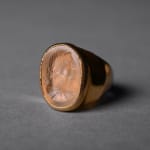Carnelian Intaglio Depicting the Goddess Artemis, 1700 CE - 1800 CE
Carnelian-Gold
FJ.6386
Further images
This intaglio is set in an 18 karat gold ring The art of glyptics, or carving on colored precious stones, is probably one of the oldest known to humanity. Intaglios,...
This intaglio is set in an 18 karat gold ring
The art of glyptics, or carving on colored precious stones, is probably one of the oldest known to humanity. Intaglios, gems with an incised design, were made as early as the fourth and third millennia BC in Mesopotamia and the Aegean Islands. They display a virtuosity of execution that suggests an old and stable tradition rooted in the earliest centuries. The tools required for carving gems were simple: a wheel with a belt-drive and a set of drills. Abrasives were necessary since the mineraIs used were too hard for a "metal edge. A special difficulty of engraving intaglios, aside from their miniature size, was that the master had to work with a mirror-image in mind.
Eternally youthful and forever a virgin Artemis was the twill sister of the god Apollo. She spurned the company of men, preferring to hunt in the woods and mountains areas of Arcadia with her female followers. On this handsome intaglio the goddess is looking to the right wearing a cloak with the tip of her quiver peaking out over her shoulder. She is noble, proud and full of spirit suitable to a powerful deity. Though in antiquity she was regarded as a personification of the moon, Artemis has always stood for the independence of women and the protection of virgin forests.
The art of glyptics, or carving on colored precious stones, is probably one of the oldest known to humanity. Intaglios, gems with an incised design, were made as early as the fourth and third millennia BC in Mesopotamia and the Aegean Islands. They display a virtuosity of execution that suggests an old and stable tradition rooted in the earliest centuries. The tools required for carving gems were simple: a wheel with a belt-drive and a set of drills. Abrasives were necessary since the mineraIs used were too hard for a "metal edge. A special difficulty of engraving intaglios, aside from their miniature size, was that the master had to work with a mirror-image in mind.
Eternally youthful and forever a virgin Artemis was the twill sister of the god Apollo. She spurned the company of men, preferring to hunt in the woods and mountains areas of Arcadia with her female followers. On this handsome intaglio the goddess is looking to the right wearing a cloak with the tip of her quiver peaking out over her shoulder. She is noble, proud and full of spirit suitable to a powerful deity. Though in antiquity she was regarded as a personification of the moon, Artemis has always stood for the independence of women and the protection of virgin forests.





